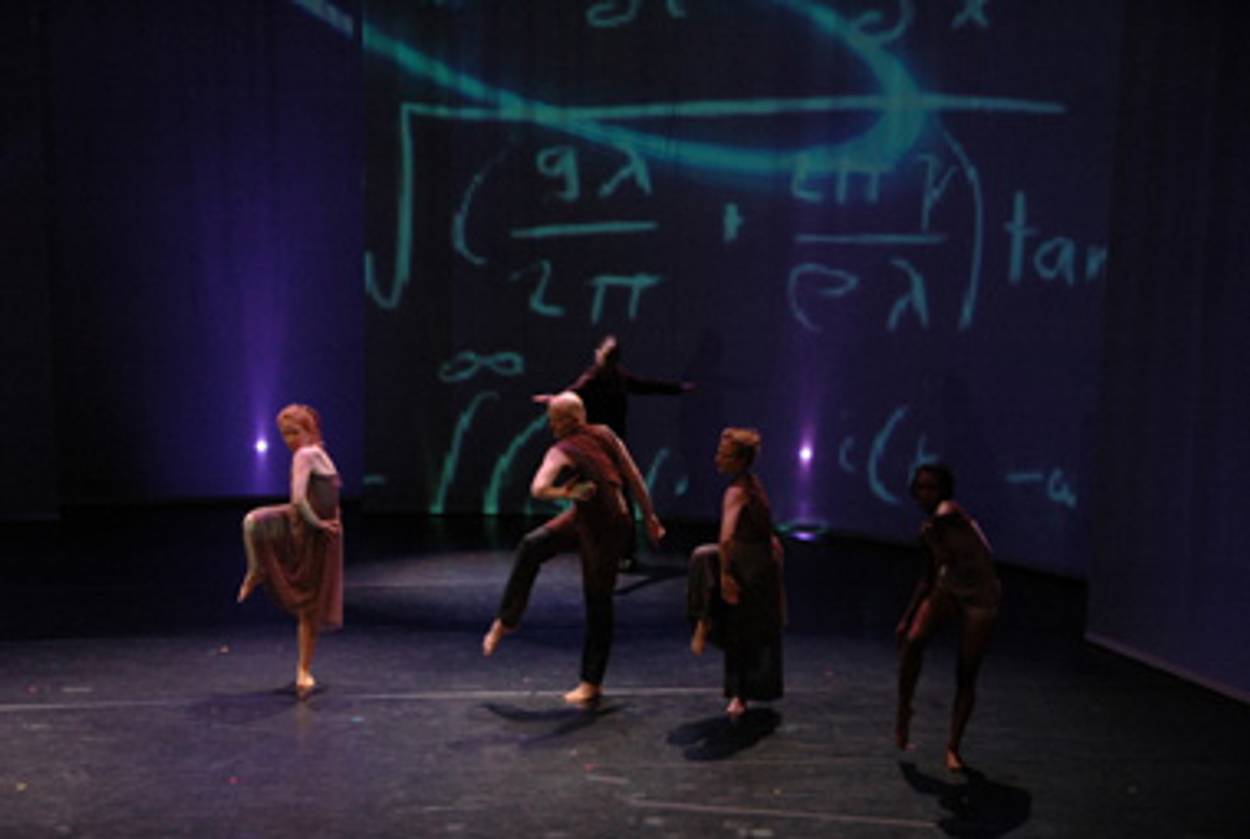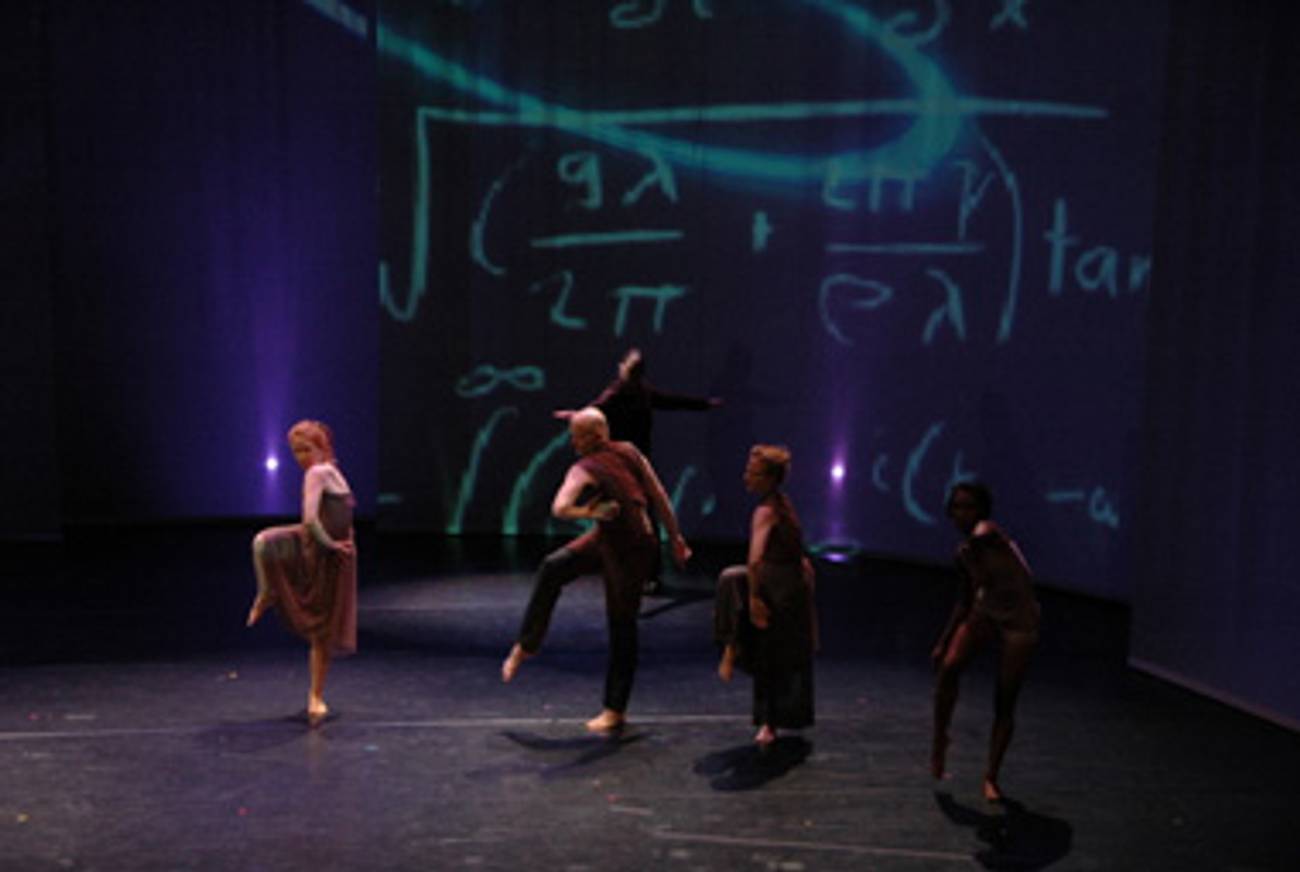First Steps
With help from scientists and rabbis, a choreographer contemplates the universe’s origins




When Liz Lerman choreographs, she doesn’t shy away from big questions. At 62, the long-time dancemaker and MacArthur “Genius” grantee has made dances that talk to God, dances about the nuclear defense budget, dances that unearth her Russian-Jewish family history, dances about prayerful sustenance and praise, and dances that map the human genome. An iconoclast in the contemporary dance world, Lerman has been shaking things up with her chamber-sized company since 1976. She challenged perceptions of what it meant to be a professional dancer by inviting senior adults to participate in her choreography and her company long before the revolution in senior fitness and community-wide arts participation took hold. Her seven full-time company members range in age from 25 to 76.
Last month, just after Rosh Hashanah, Liz Lerman Dance Exchange, based in Takoma Park, Md., tackled the most elemental of questions: How did our planet come into being? The Matter of Origins is an expansive, multimedia theatrical work that by dint of collaborative contributions from scientists, artists, even a rabbi or two, ferrets out explanations for the origin of the universe. It’s a step into the unknown that has taken Lerman and her company on a three-year journey. They met with scientists working on NASA’s Hubble Space Telescope and the Large Hadron Collider at CERN in Switzerland, they consulted with rabbis, including former dance company rabbi-in-residence David Bauer, a Reconstructionist rabbi at the Jewish Community of Amherst, Mass.
When Origins made its world premiere at the University of Maryland’s Clarice Smith Performing Arts Center in College Park last month, the two-part evening began with the company on stage but concluded with members of the audience taking tea and eating cake around tables with scientists, philosophers, poets, scholars, clergy, and discussion facilitators whom Lerman calls “provocateurs.”
“Since I was a little, little, girl I have wondered, as I’m sure we all do, where we come from,” Lerman said during a rehearsal break at the company’s Takoma Park studio. “It’s so, so overwhelming that it’s easy to just put those thoughts away … but I suppose that I can think about it a little more because I’m older.” Over the decades Lerman has fairly regularly dealt with Jewish thematic material in dance works ranging from Miss Galaxy and Her Three Raps With God to The Good Jew? Shehechianu, The Hallelujah Project, even 2007’s Small Dances About Big Ideas, which delved into genocide, the Nuremberg trials, and reconciliation.
While the choreographer noted that Origins is not an intentionally Jewish work, the question of who we are and where we come from arrives with a Jewish subtext. “In exploring the ongoing question about what is Jewish art, I feel that of course everything I make is Jewish because it’s informed by that piece of who I am. It’s not simply about whether I mention something in Hebrew,” she said. Even so, listen carefully, the Hebrew is present in a voice-over of Genesis 1, read by dancer, and observant Jew, Shula Strassfeld.
California-born, Lerman was raised in Washington, D.C. and Milwaukee, where she gleaned fundamental ideals about Judaism as an agent of social, even political, change from her father, an outspoken figure in the labor and civil rights movements during the 1960s. At the outset of her choreographic career, Lerman worked on the fringes of the organized Jewish community, but more recently she has found herself engaging with it directly, serving on the Synagogue 3000 task force, teaching rabbinical students at Hebrew Union College, and receiving a “Golda” award from American Jewish Congress.
“One reason Liz and the Dance Exchange, and other similar endeavors, excite me so much is that I see an attempt to synthesize the body and the word through dance,” said Arthur Waskow. The rabbi, author, and founder and director of the Shalom Center in Philadelphia has had a long association with Lerman, once even serving as a last-minute stand-in for the messiah in one of the choreographer’s early works. Asked about the Jewish nature of Lerman’s extensive dance theater projects, Waskow takes the long view, citing the evolution of rabbinic Judaism, which valued the word and the book over the body and the land as a means of worship and a conduit to God. Jews for the most part became divorced from their physical roots, especially when they were no longer connected to the land of Israel, he said. “Dance, especially with the Dance Exchange, uses words as part of the dance, integrates thought, words, movement, even danced prayer. I see that as a growing aspect for contemporary Jews to getting in touch with God. In that sense, the dance process is really important to the future of Judaism.”
With Origins Lerman attempts to bridge the barriers between science, religion, and art. “I knew I would pose Genesis in relationship to origin myths of other cultures and to the big bang,” she said. “I think the originators of these myths may have come to them through observation, through their own experiences in the world, through imagination and dreams. It might have been equivalent to the microscopes and telescopes” scientists use today.
Torah, Waskow said, “is a fusion of what today we think of as the separate categories of religion, science, and art. Torah as a book, as a process, didn’t see them as separate, but as a continuous way of understanding the universe.” The poetry and literary passages of the Bible, he contends, were a means to understand the complexities of the world of that time. “Part of the way people did that was to represent through art, dance, and music the many different versions of human and other life forms. In that sense, I think that Liz is at the center of a reemergence of a way of unfolding the world.”
***
“I’m an astrophysicist,” said Mario Livio, by way of introduction. A senior member of the team at the Hubble Space Telescope Science Institute, and head of the office of public outreach, he has spent a career looking out at the heavens to study how galaxies, stars, and planets formed and how life on Earth came about. “As humans we’re interested in origins of all kinds,” Livio acknowledged, speaking from his office near the Johns Hopkins University campus in Baltimore. “While we’re curious about the universe, we’re also interested in origins of our own families and the mostly philosophical questions of religions.”
A self-professed art lover, Livio, born in Romania but raised in Israel, often looks for ways to collaborate with artists and in the past offered joint programs with both the Baltimore Symphony Orchestra and the Maryland Institute College of Arts. But he still notes differences between artistic and empirical approaches to origin stories. “In my scientific work and in the work of my colleagues, we try to explain the phenomena that we see, and we try to predict the phenomena that perhaps we haven’t seen yet. Artists don’t try too much to explain, but to describe not only what they see but the emotional response that we as humans have when we are faced with those phenomena.” Art contains an emotional component that science often eschews.
Aside from spending a day observing a rehearsal and speaking at length with Lerman and the dancers about advances in astrophysics and space science, Livio appears on video in the piece as a guide of sorts, during the second act tea party. That’s when Lerman’s dancers meander through tables and serve the audience cake baked from the same recipe that fed the atomic physicists who worked on the Manhattan Project in Los Alamos during World War II. Lerman hopes it will provide an opportunity for the viewers to process the thicket of material from the first part of the evening, where dancers in pairs and groups collide and split apart, embody mathematical equations and atomic particles, explore symmetry, dissonance, and other physical properties inspired by a visit to the supercollider at CERN and other physics labs around the country.
“Audiences will have to work at this concert,” Lerman admitted. “First they’ll get to take in the beauty of act one, but then they’ll be expected to engage and grapple with these ideas.”
Three-year company member Strassfeld, 63, unexpectedly found contentment in the insurmountable questions the work raises. “I’m finding, as we delve into the material and particularly the physics, a comfort with the question, with knowing that there isn’t really an answer. This is very Jewish … the questioning itself. And you answer the question with another question, which leads you to yet another question. Maybe the answer is really learning to be comfortable in a place of questioning rather than of knowing.”
The piece will be performed at Wesleyan University in February, at New Jersey’s Montclair State University in March, and at Arizona State University in April.
Lisa Traiger writes frequently on dance, theater, and the performing arts for the Washington Jewish Week, The Washington Post Weekend, and other publications.
Lisa Traiger writes frequently on dance, theater, and the performing arts for the Washington Jewish Week, The Washington Post Weekend, and other publications.